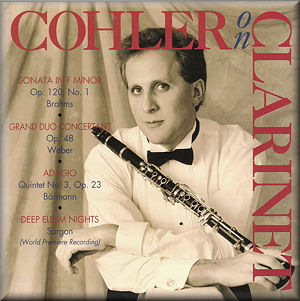 |
 |
| 
Ongaku
|
Cohler on Clarinet
Johannes BRAHMS
(1833-1894) Sonata in F minor for Clarinet and
Piano, Op.120 No.1 (1894) [22:34]
Carl Maria von WEBER
(1786-1826) Grand Duo Concertant, Op.48 (1816)
[22:38]
Heinrich Joseph BÄRMANN (1784-1847)
Quintet No.3 in E-flat major, Op.23 (1820-1821) [5:02] (arrangement
of second movement for piano accompaniment)
Simon A. SARGON (b.1938) Deep
Ellum Nights: Three Sketches (1991) [12:19]
 Johathan Cohler (clarinet); Judith Gordon (piano)
Johathan Cohler (clarinet); Judith Gordon (piano)
rec. May 1992, Harward University. DDD
 ONGAKU 024-101 [63:31]
ONGAKU 024-101 [63:31] 
|
|
|
Some clarinet players have their own sound. It’s pretty much the same with vocalists: many sopranos sound alike, but you can’t mistake Maria Callas for anyone else. Jonathan Cohler also has his own sound, which reminded me a bit of Richard Stoltzman. It also has this “full-steam ahead” feeling, and you always sense the presence of the player behind the instrument. It is not hard-driven, but it is driven. This is not good or bad per se, but it suits some music better than others.
And so, on this disc, it does not suit the Brahms Sonata Op.120 No.1 so well. Acrobatic jumping comes instead of free flight. The first movement is passionate, but it is also impatient, which is not really healthy for it. The Andante is not rushed and lets the music breathe freely. But the clarinet sound seems to me to be too sharp here: if this is honey, it is spicy. After this point, all is well. The Allegretto is marvellous, and the leaps and “digs” that can be so “bubbly” in other performances are very accurate and sensitive. The finale is as exuberant as one could wish, and the clarinet projects happiness most sincerely.
What could be wrong for Brahms, or at least for part of it, works well from the very start in Weber’s Grand Duo Concertant. The Allegro is playful and joyous, and Cohler’s sharpness and spiciness are most welcome here. He effortlessly dispatches the virtuosic demands of this score. The slow movement is very operatic, with dramatic and contemplative episodes, and the clarinet gives us a perfect bel canto performance. Judith Gordon provides the full ‘orchestral’ background. The finale returns to happy brilliance. Cohler’s lightness of touch in the running scales and arpeggios is impressive. After a darker middle episode, we soon enter a victorious stretta – one of those Weber did so well in his clarinet concertos.
From the same period comes the next piece, Bärmann’s Adagio from Clarinet Quintet No.3, arranged for piano accompaniment. It is a sweet, free-flowing aria. The clarinet sound is elegant and accurate, yet I would appreciate more subtlety, especially in the first section.
Deep Ellum Nights by Simon Sargon are exactly what they claim to be: three sketches. They evoke the mood of a certain section of the city of Dallas in the first half of the XX century – its local analog of the Bourbon street area in New Orleans. The names of the parts fairly describe the character of each. Dark and Smoky starts as a relaxed, almost improvisatory, blues, which is interrupted by a sharp-edged, bumpy episode, and is gradually restored. The jazzy abilities of the clarinet are put to good use here – but are still better in the second sketch, Quiet and Easy. This one has some Gershwin flair, in its steady piano pulse and sliding harmonies. It reaches an impressive climax and then calms away. In his liner-notes Cohler describes the closing Tempo di Rag as “a coquettish ragtime”. The music is light and careless, and the two instruments are like two dance partners who know their steps so well that they dare to improvise. All three sketches are listenable and moderately memorable, albeit somewhat two-dimensional. They provide a good display for the jazzy side of the two instruments, and both performers are well up to the mission.
Jonathan Cohler also contributes interesting and informative liner-notes. This is a rare case when the writing is concentrated, expressive and entertaining, and at the same time contains all the information I could probably ask for.
The weak point is the recording quality. The instruments are placed remotely, and, while the clarinet has the ability to cover the distance, the piano is just too weak. This means that the balance of the instruments is shifted, and the clarinet is too prominent even in Weber’s Duo, which is supposed to be more a duo of equals. This also means that I cannot say much about the piano playing of Judith Gordon: it is somewhere there, for sure, but you have to dig for it. Also, there are at times “shades and artifacts” surrounding the clarinet sound. The sound-picture is rather flat. Ongaku will do better with their second disc, which is predictably entitled “More Cohler on Clarinet”. Also, it will contain a program of more “active” pieces that go better with Cohler’s “full-steam ahead” clarinet playing. Here, it is not very suitable for Brahms, though the rest is fine, especially the Weber. For Brahms I would definitely look elsewhere.
Oleg Ledeniov
|
|

